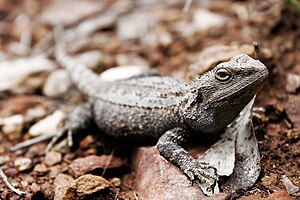Eastern bearded dragon
| Eastern bearded dragon | ||||||||||||
|---|---|---|---|---|---|---|---|---|---|---|---|---|

Eastern bearded dragon ( Pogona barbata ) |
||||||||||||
| Systematics | ||||||||||||
|
||||||||||||
| Scientific name | ||||||||||||
| Pogona barbata | ||||||||||||
| ( Cuvier , 1829) |
The eastern bearded dragon ( Pogona barbata ) is a species of lizard from the genus of the bearded dragon ( Pogona ). The species occurs in the east and southeast of Australia from the coast to about 1000 km inland.
features
Eastern bearded dragons are sturdy lizards with a clearly flattened body, relatively short legs and an elongated triangular head when viewed from above. They reach about 25 cm head-trunk length with a total length of up to 65, rarely 75 cm. Their basic color is usually gray, more rarely also reddish, yellowish or simply brown. The coloration can change depending on your mood and body temperature. A light, diamond-shaped pattern is pronounced in young animals, but pale or absent in older animals. The throat and tip of the tail are dark gray to black, the inside of the mouth usually bright yellow. At the back of the head, behind the mouth and in a wide strip on the flanks there are rows of significantly enlarged, spiky scales. The "beard", a throat pouch with clear spines at the rear end, is well developed. The scales on the body are irregular with predominantly roof-tile-like, slightly keeled scales and individual, larger, clearly keeled scales in between. The scales on the stomach are also keeled.
The males are slightly larger, have a wider head, a more pronounced, darker-colored beard and a pale green to bluish coloration of the front head area. The females often have bite marks from the mating on the back of the head.
distribution and habitat
The species occurs in the east and southeast of Australia from the coast to about 1000 km inland. The distribution area extends from Cairns in the state of Queensland in the northeast to the southern Eyre Peninsula in South Australia, with the exception of the cooler regions in the southeast. Eastern bearded dragons inhabit open forest and scrubland and often also populated areas.
Way of life
Insects, worms, small mammals and plants serve as food. The animals are very territorial, the ranking is largely determined by their size. There are over 70 known postures that are used for sunbathing and communication between conspecifics. Bearded dragons try to avoid threats by fleeing or hiding, but they can also threaten the enemy by flattening the body, puffing up the beard, hissing, showing the inside of the yellow mouth and making short leaps.
The breeding season is between August and December. To mate, the male mounts the female and holds it in position by biting the throat and neck. The female ends mating by lifting her head almost vertically. The females can produce up to three, but usually two, clutches of 15 to 35 eggs each at an interval of about six weeks. They are buried in damp sand and not guarded.
The species is one of the best-known reptiles in Australia due to its size, its conspicuous resting places and its frequent occurrence in the settlement area.
swell
- Steve Wilson, Gerry Swan: A complete guide to the reptiles of Australia. 2nd Edition. New Holland Publishers, Sydney et al. 2008, ISBN 978-1-877069-46-8 , pp. 348-349.
Individual evidence
- ↑ a b c d Species description at James Cook University ( Memento from May 7, 2006 in the Internet Archive ) (English; PDF; 17 kB)
- ↑ Manfred Au: Bearded Dragons. Gräfe and Unzer, Munich 2008, ISBN 978-3-8338-1164-7 , p. 16.
Web links
- Pogona barbata in The Reptile Database
- Pogona barbata inthe IUCN 2013 Red List of Threatened Species . 2. Posted by: Hutchinson, M., 2009. Retrieved January 31, 2014.

